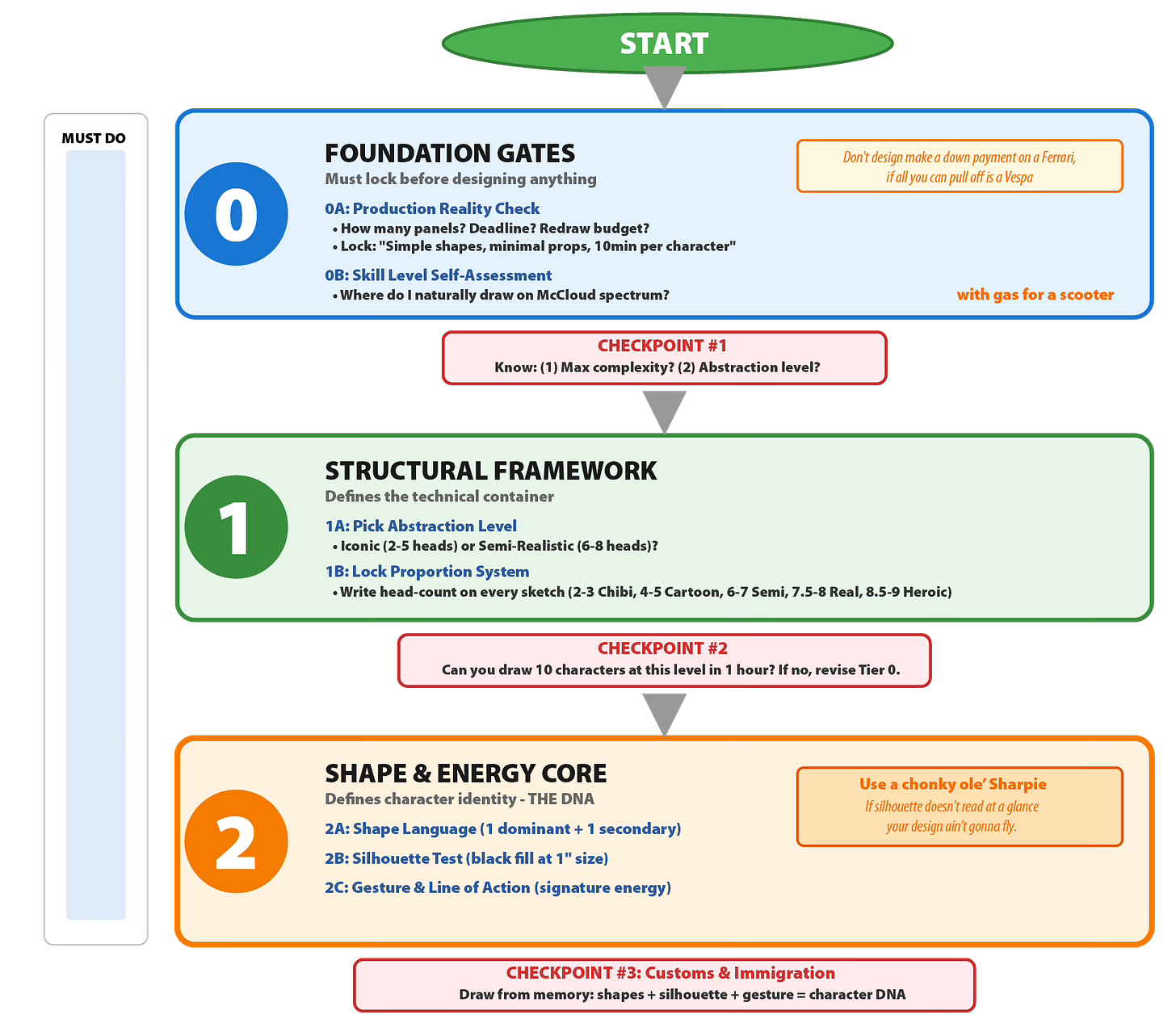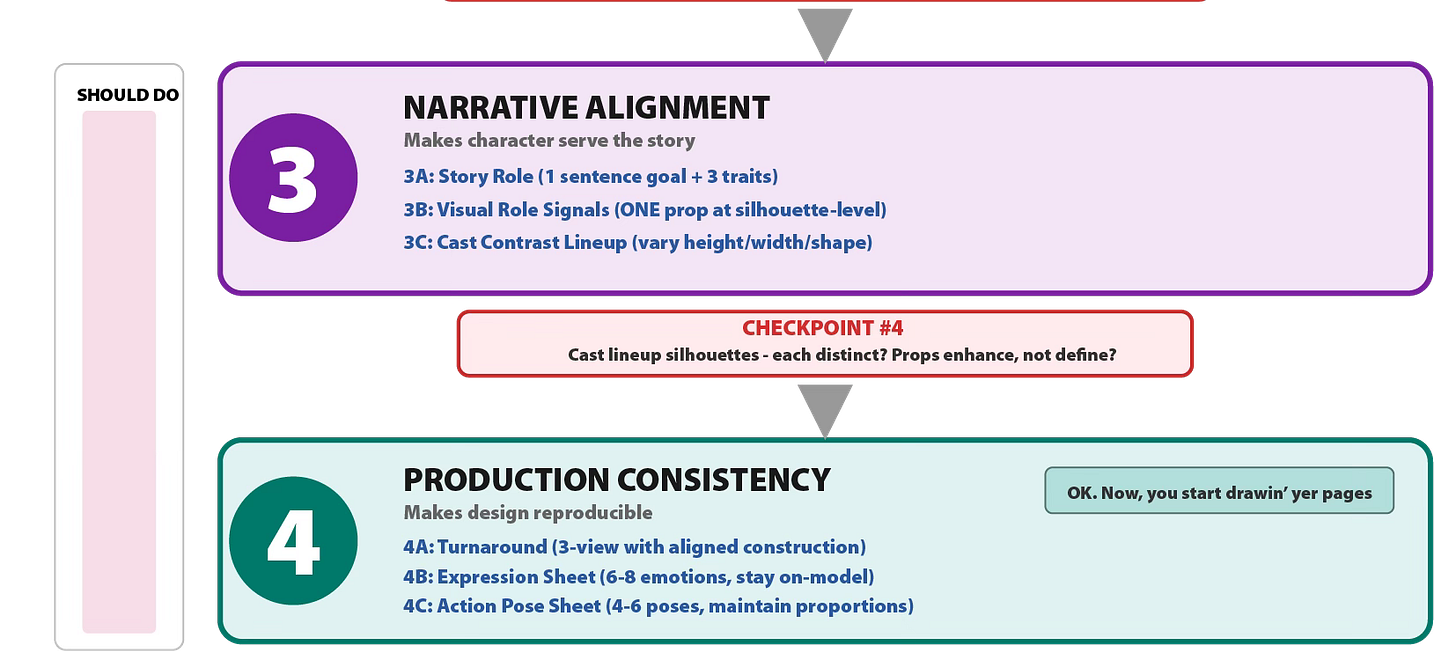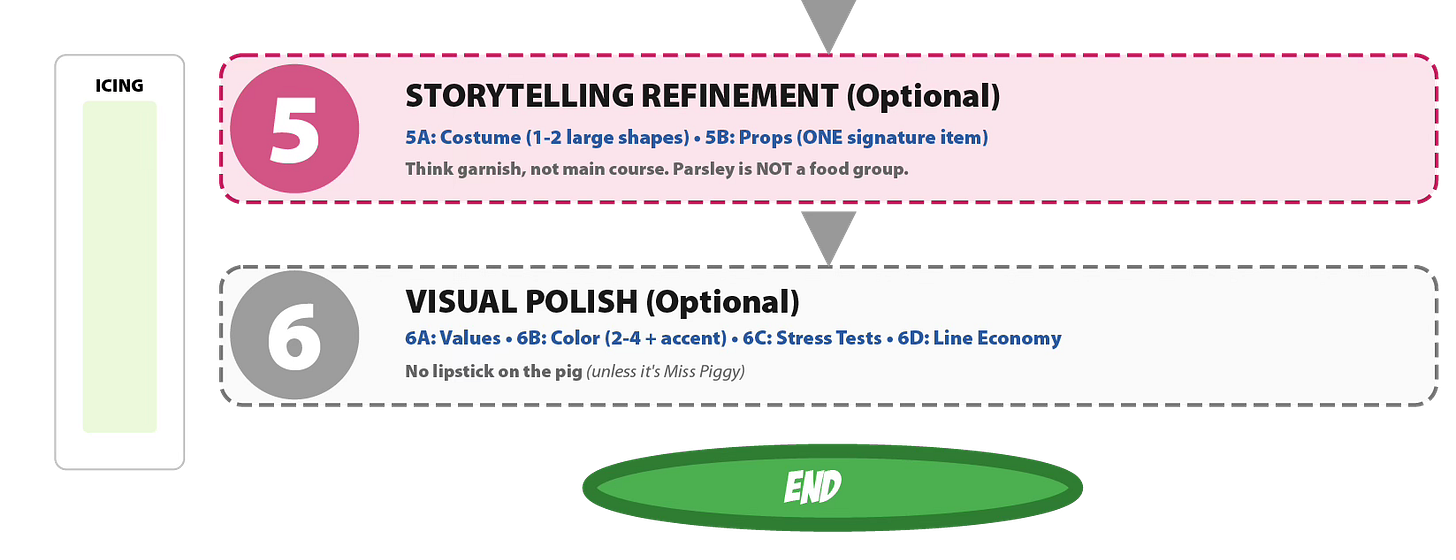♦♦[ART] Character Design That Works: Abstraction, Proportion, and Story in the Right Sequence
Character design isn’t about drawing better costumes. It’s about making the right decisions in the right order—so your story actually makes it off the blocks and out of the garage.
If you enjoy spending three months redesigning boots and buckles, this article isn’t for you. But if you’d rather actually finish a comic, then welcome: this is character design without the treadmill, without gettin’ lost in the weeds, without the fifty “final” versions. Just the steps that matter, in the order that keeps your story moving.
From Foundation to Refinement in a logical, step-by-step approach
TIER 0: FOUNDATION GATES (Lock this down before designing anything)
This is where most people skip straight to failure. If you don’t know what you can actually draw, or how much time you’ve got, you’re designing a Ferrari when you’ve only got gas for a scooter. Lock your limits first—it’s not a downgrade, it’s survival.
These aren’t about the character — they’re about the CANVAS and CAPABILITY
Exercise 0A: Production Reality Check
How many panels need to get drawn? Do I have time for redraws? What’s my deadline?
Decision to lock: Maximum design complexity I can sustain
Output: One-sentence design promise (e.g., “simple shapes, minimal props, clean lines I can draw in 10 minutes”)
Why first: Prevents designing an 8-head realistic character for a 100-panel comic due in 2 weeks
Exercise 0B: Skill Level Self-Assessment
Can I my character from reference in 5 minutes
Compare to McCloud spectrum: Where do I naturally draw? (Iconic? Semi-realistic?)
Decision to lock: My current abstraction range
Output: Honest assessment: “I can sustain 4-5 head cartoon style” or “I can handle 6-7 head semi-realistic”
Why first: Matches ambition to capability, prevents overreach
✓ Gate Check: Do not proceed until you know: (1) How complex can I draw repeatedly? (2) What abstraction level matches my skill?
TIER 1: STRUCTURAL FRAMEWORK (Defines the technical container)
Here’s the big fork in the road: abstraction and proportion. McCloud already gave us the map. Pick where you live—iconic or realistic—and then write down your head count. If you don’t commit here, everything downstream leads to thundering waterfalls and the rocks beneath them.
These decisions create the “rules of the world” — change these later = complete redesign
Exercise 1A: Pick Your Abstraction Level
Using McCloud’s spectrum, choose your commitment: Iconic like a stick figure or a happy face or Semi-Realistic like Batman by Brice Timm. Or are you going all the way like Superman by Alex Ross?
Decision to lock: Where on the spectrum
Test: Draw 3 quick figures at your chosen level — can you do this repeatedly?
Output: Style commitment statement
Why here: Everything downstream depends on this — proportions, detail density, anatomy needs
Exercise 1B: Lock Proportion System
Choose heads-tall ratio and write it on every sketch
2-3 heads = Chibi, 4-5 = Cartoon, 6-7 = Semi-realistic, 7.5-8 = Realistic, 8.5-9 = Heroic
Decision to lock: Exact head count
Test: Draw 5 figures at this proportion from different angles
Output: Proportion template you’ll use for all characters
Why here: This ratio determines anatomy complexity, detail level, and rendering time
✓ Gate Check: Can you draw 10 characters at this abstraction level and proportion system in an hour? If no, revise Tier 0.
TIER 2: SHAPE & ENERGY CORE (Defines character identity)
This is the DNA of your character. Forget the zippers and necklaces—if the silhouette doesn’t read, the design’s already dead. How to nail it? Use a chonky-ass sharpie. Maybe even the one with a chisel tip, so you can’t make tiny marks. Impossible.
Shape language, silhouette, and gesture are the core. Nail those, and your character is recognizable even as an inch-tall black smudge.
These decisions make the character RECOGNIZABLE — the irreducible minimum
Exercise 2A: Shape Language Assignment
Pick ONE dominant shape (circle/square/triangle) for each character
Add ONE secondary shape for variety
Decision to lock: Primary and secondary shape
Test: Draw character as pure geometric construction — head as circle, body as rectangle, etc.
Output: Shape formula (e.g., “Circle head + square body = friendly but stable”)
Why here: This IS the character’s visual personality before any details exist
Exercise 2B: Silhouette Test (Black Fill)
Draw character outline and fill completely with black
At 1-inch size, is it still identifiable?
Decision to lock: Silhouette readability
Test: Show 3 classmates — can they describe the character from silhouette alone?
Output: Clear silhouette that passes the test
Why here: If this fails, no amount of detail saves it
Exercise 2C: Gesture & Line of Action
Draw 10 quick 30-second poses exploring different energy states
Find the character’s signature gesture — their “default” stance
Decision to lock: Core line of action and attitude
Test: Can you draw this gesture from memory in 10 seconds?
Output: Signature gesture/force sheet
Why here: This is the character’s LIFE — their energy must be established before adding structure
✓ Gate Check: Without looking at reference, draw the character from memory. Did you remember: (1) The shapes? (2) The silhouette? (3) The gesture? These three = the character’s DNA.
TIER 3: NARRATIVE ALIGNMENT (Makes character serve the story)
Now it’s time to stop drawing in the inky black void. Who is this character in the story? What do they want? Is there a prop or costume cue that gives us a hint? Don’t let the details carry the weight—the design itself should already be doing the heavy lifting.
These decisions connect visual design to narrative function
Exercise 3A: Story Role Definition
Write one-sentence character goal/motivation
List 3 personality traits
Decision to lock: Who they are narratively
Test: Does your shape language match this personality? (Aggressive triangle for friendly character = mismatch)
Output: Character brief (role, goal, traits)
Why here: NOW you align technical decisions (shapes, gesture) with narrative purpose
Exercise 3B: Visual Role Signals
Add ONE prop or costume element that signals narrative role
Keep it big and simple (silhouette-level)
Decision to lock: Key visual identifier
Test: Remove the prop — does character still work? (Should be YES)
Output: Character with signature element
Why here: Story details should enhance, not carry, the design
Exercise 3C: Cast Contrast Lineup
Draw all main characters side-by-side at same scale
Compare: heights, widths, shapes, silhouettes
Decision to lock: Relative scaling and contrast
Test: Are any two characters too similar? Adjust one.
Output: Full cast lineup showing variety
Why here: Characters exist in context — they must differentiate from each other
✓ Gate Check: Line up cast in silhouette. Can you identify each character? Do they vary in height/width/shape? Do props enhance but not define?
TIER 4: PRODUCTION CONSISTENCY (Makes design reproducible)
This is where the rubber meets the road. If your character can’t survive a turnaround or an expression strip, they’re not ready for a comic. It’s great if you can do this before starting pages. But it’s not REQUIRED. Just get to drawing.
You don’t need Pixar-level sheets, but you do need a design that holds up across pages, poses, and moods. Otherwise, you’ll redraw your character again and again, and lose all your hair doing it.
These decisions enable you to draw the character repeatedly on-model
Exercise 4A: Turnaround Construction (also called a “three-view”)
Draw front, side, back views with aligned construction lines
Eyes, shoulders, hips must align across all views
Decision to lock: Structural proportions in 3D space
Test: Draw character from 3/4 view without reference — does it look consistent?
Output: 3-view turnaround with construction guides
Why here: You can’t maintain consistency until shape, proportion, and silhouette are locked
Exercise 4B: Expression Range Sheet
Draw 6-8 facial expressions (happy, sad, angry, surprised, neutral, thinking, etc.)
Keep face structure consistent while features deform
Decision to lock: Emotional range
Test: Draw expressions from memory — do features stay on-model?
Output: Expression sheet showing face flexibility
Why here: Performance testing requires solid structural foundation
Exercise 4C: Action Pose Sheet
Draw 4-6 full-body action poses (walking, running, sitting, reaching, etc.)
Maintain proportions and silhouette across all poses
Decision to lock: Movement vocabulary
Test: Gesture → Structure → Details for each pose
Output: Action sheet proving design flexibility
Why here: Design must work in motion, not just static poses
✓ Gate Check: Can you draw this character in any pose, from any angle, in any expression, without reference? If no, strengthen Tier 4.
TIER 5: STORYTELLING REFINEMENT (Enhances narrative through detail)
Okay, now let’s open the door to some more fun—costumes, props, accessories. But keep it lean. One prop. One costume shape. If you load them with clutter, you’re punishing your future self. Think of this as a garnish, not the main course. Parsley is NOT a food group.
These are genuinely optional enhancements — character works without them
Exercise 5A: Costume Design (Function First)
Design clothing with 1-2 large shapes (coat, armor, hat)
Ensure costume follows body gesture, doesn’t fight it
Decision to add: Clothing that reinforces role and era
Test: Remove costume — does character still read clearly? (Should be YES)
Output: Costumed character with cultural/era context
Why here: Costume is enhancement, not foundation
Exercise 5B: Props & Accessories
Add ONE meaningful prop that serves story function
Keep it drawable at thumbnail size
Decision to add: Signature prop
Test: Is prop simple enough to draw 100 times without suffering?
Output: Character with signature tool/item/companion
Why here: Props are storytelling flavor, not structural necessity
✓ Gate Check: Strip away costume and props. Does the character still work? (If no, you’re detail-dependent — reinforce Tiers 2-3.)
TIER 6: VISUAL POLISH (Production value, not definition)
This is the shiny stuff that makes people go “ooh.” Values, colors, textures. But don’t be fooled: none of this fixes a bad design. Hell, lots of comics don’t have color anyway, and they’re still great stories. If the silhouette works and the proportions are solid, polish will make it sing. If not, you’re just painting lipstick on a pig. OK, if it’s Miss Piggy. Not OK, if it’s a sow in a story about princesses.
These make the design look finished but don’t change what it IS
Exercise 6A: Value Structure (Light/Medium/Dark)
Assign 3 values to character in grayscale
Test: photocopy design — does it read clearly in B&W?
Decision to add: Value pattern
Output: Character with clear light/shadow separation
Why here: Values enhance readability but shouldn’t be required for identification
Exercise 6B: Color Strategy (Limited Palette)
Choose 2-4 main colors + 1 accent
Apply to character, test at thumbnail size
Decision to add: Color scheme
Test: Desaturate design — does it still work? (Should be YES)
Output: Color study with palette notes
Why here: Color enriches but doesn’t define character
Exercise 6C: Stress Tests (Quality Control)
Draw character at 1-inch size — identifiable?
Silhouette test — readable?
Three sequential panels (talk, walk, emote) — stays on-model?
From memory in 2 minutes — can you do it?
Output: Passed quality checks or revision notes
Why here: Final validation before polish
Exercise 6D: Final Line Economy
Refine line quality, add subtle textures where needed
Remove any marks that don’t serve form
Decision to add: Surface polish
Output: Presentation-ready character design
Why here: Polish comes last — never mistake rendering quality for design strength
The Exercise Progression Summary
MUST DECIDE FIRST (Tiers 0-1):
Production constraints & skill level (what CAN I draw?)
Abstraction level & proportion system (what RULES govern this?)
MUST DECIDE SECOND (Tier 2):
Shape language, silhouette, gesture (what IS the character visually?)
MUST DECIDE THIRD (Tier 3):
Story role, visual signals, cast contrast (WHO is this character narratively?)
SHOULD DECIDE FOURTH (Tier 4):
Turnarounds, expressions, action poses (can I REPRODUCE this?)
CAN ADD FIFTH (Tier 5):
Costume, props, accessories (how does CONTEXT enhance this?)
CAN ADD LAST (Tier 6):
Value, color, polish (what’s the FINISH quality?)
How to Use This Scaffolding
Week 1: Exercises 0A-0B + 1A-1B (foundation gates + structural framework) Week 2: Exercises 2A-2C (shape & energy core) Week 3: Exercises 3A-3C (narrative alignment) Week 4: Exercises 4A-4C (production consistency)Week 5: Exercises 5A-5B (storytelling refinement) Week 6: Exercises 6A-6D (visual polish)
The gate-check system prevents advancement without mastery. Students cannot add costume until silhouette works. Cannot polish color until turnaround is consistent. This eliminates decision paralysis by creating clear “you must do THIS before THAT” sequencing.





